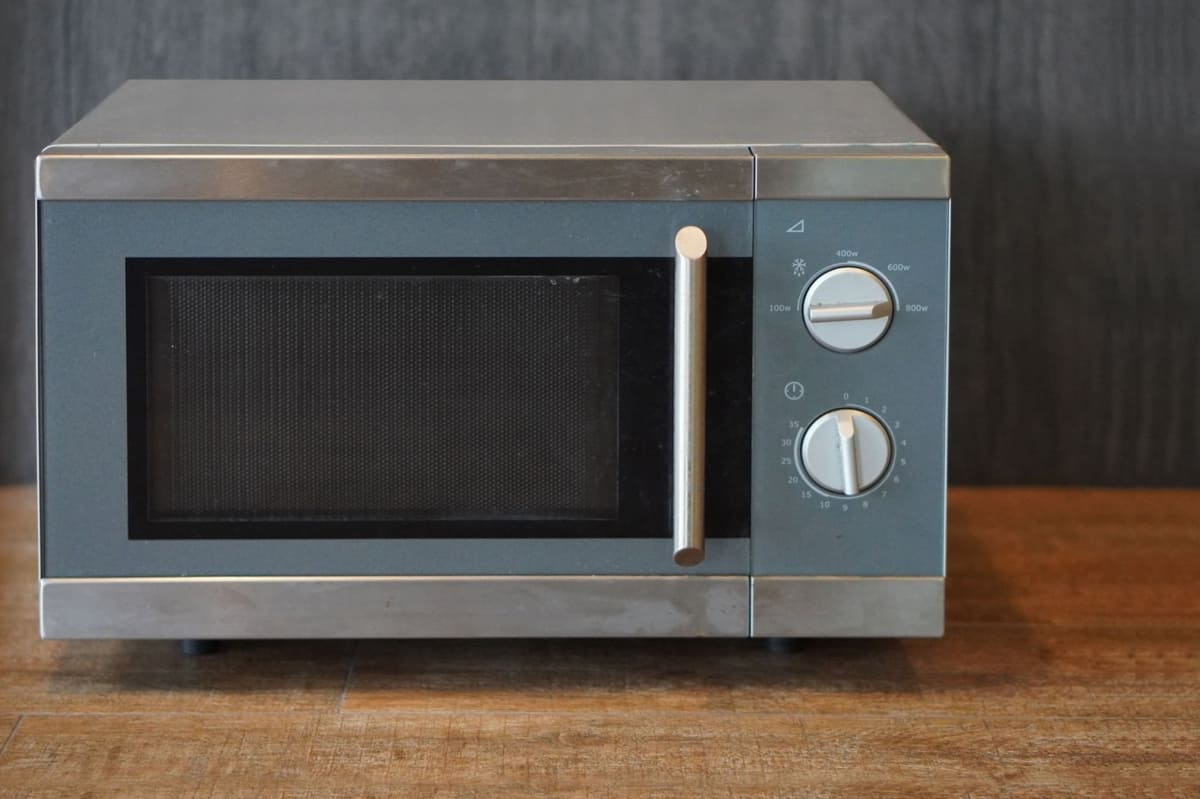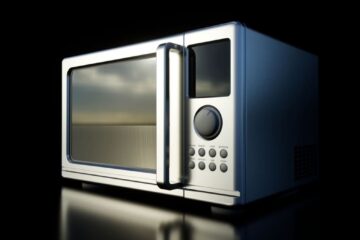Microwave ovens have become an essential part of modern kitchens. They are convenient, fast, and easy to use. However, have you ever wondered about the metal grid or dots on the microwave window? Do you know why they are there? In this article, we will explore the physics of microwave cooking, the design and construction of microwave ovens, the benefits and drawbacks of metal grid or dots on microwave windows, alternatives to these designs, safety concerns, and cleaning and maintaining them.
What are the metal grids or dots on the microwave window?
If you look closely at the microwave window, you will notice a metal grid or dots. These designs are meant to prevent microwaves from leaking out of the oven while allowing you to see the food inside. The dots are small holes in the microwave window, while the grid is a metal mesh that covers the window.
The Physics of Microwave Cooking
What are microwaves?
Microwaves are a form of electromagnetic radiation with wavelengths ranging from one millimeter to one meter. These waves have a frequency of around 2.45 gigahertz, which is the frequency used in most microwave ovens. Microwaves are produced by a magnetron, a device that converts electrical energy into microwaves.
How do microwaves cook food?
Microwaves work by exciting the water molecules in food, causing them to vibrate rapidly. This rapid movement generates heat, which cooks the food. The microwaves penetrate the food from the outside, so the outside of the food cooks faster than the inside. To ensure even cooking, the microwave oven rotates the food on a turntable.
What is the role of the metal grid or dots in this process?
The metal grid or dots on the microwave window play an essential role in the cooking process. They prevent microwaves from escaping the oven, which ensures that they cook the food and not the kitchen. Without the metal grid or dots, the microwaves could escape and cause interference with other electronic devices or harm human health.
The Design and Construction of Microwave Ovens
Microwave oven components and their functions
A microwave oven has four essential components: the magnetron, the waveguide, the turntable, and the control panel. The magnetron produces the microwaves, while the waveguide directs them towards the food. The turntable rotates the food to ensure even cooking, and the control panel allows you to set the cooking time and power level.
The microwave window: purpose and construction
The microwave window allows you to see the food inside the oven. It is made of a special type of glass that can withstand the high temperatures and pressure of the microwaves. The metal grid or dots are placed on the window to prevent microwaves from leaking out.
Metal grid or dots: their role in the microwave oven design
The metal grid or dots are an essential part of the microwave oven design. They prevent microwaves from escaping and interfering with other electronic devices or causing harm to human health. The metal grid or dots also ensure that the microwaves are distributed evenly throughout the oven.
The Benefits of Metal Grid or Dots on Microwave Windows
Preventing microwaves from leaking out
The metal grid or dots on the microwave window prevent microwaves from leaking out of the oven. This ensures that they cook the food and not the kitchen or surrounding area.
Ensuring even distribution of microwaves
The metal grid or dots also ensure that the microwaves are distributed evenly throughout the oven. This ensures that the food is cooked evenly and prevents hot spots or cold spots.
Preventing damage to the microwave window
The metal grid or dots on the microwave window not only play a role in ensuring even distribution of microwaves and preventing leaks, but they also help protect the microwave window from damage. Without the metal grid or dots, the microwave window would be more susceptible to cracking or shattering from the intense heat and pressure created during the cooking process.
The grid or dots act as a buffer, absorbing some of the microwaves and reducing the amount of energy that reaches the window. This not only protects the window from damage but also extends the lifespan of the microwave oven.
The Drawbacks of Metal Grid or Dots on Microwave Windows
While the metal grid or dots on the microwave window serve an important function, they do have some drawbacks that are worth considering.
Obstructing the view of the food being cooked
The metal grid or dots on the microwave window can obstruct the view of the food being cooked, making it difficult to check on its progress without opening the microwave door. This can be frustrating, especially when cooking delicate dishes that require close monitoring.
Limiting the size of containers that can be used
Another potential drawback of metal grid or dots on microwave windows is that they can limit the size of containers that can be used in the microwave. Since the grid or dots absorb some of the microwaves, the food closest to them heats up more quickly than the food in other areas of the microwave. This can create hot spots and uneven heating, which can be a problem when using larger containers that don’t fit as easily around the grid or dots.
The Alternatives to Metal Grid or Dots on Microwave Windows
While metal grid or dots are the most common way to design a microwave oven window, there are alternatives available that don’t rely on this technology.
Microwave ovens without metal grids or dots:
How do they work? Some microwave ovens use a solid piece of glass or plastic for the window instead of a metal grid or dots. These windows are designed to be thicker and stronger than traditional microwave oven windows, and they’re able to withstand the intense heat and pressure created during the cooking process.
Are they as efficient as those with metal grids or dots?
While microwave ovens without metal grids or dots are able to cook food just as efficiently as those with metal grids or dots, they may not be as effective at preventing leaks or ensuring even distribution of microwaves. This is because the metal grid or dots are specifically designed to serve these functions.
Advantages and disadvantages of metal grid or dot-free microwave ovens
One advantage of metal grid or dot-free microwave ovens is that they offer an unobstructed view of the food being cooked, making it easier to monitor its progress. They also allow for larger containers to be used without the risk of uneven heating.
However, metal grid or dot-free microwave ovens may be more expensive to manufacture and may not be as widely available as traditional microwave ovens. Additionally, they may not be as effective at preventing leaks or ensuring even distribution of microwaves.
The Safety Concerns of Microwave Ovens
One of the most common concerns people have about microwave ovens is the potential health risks associated with electromagnetic radiation.
Electromagnetic radiation and its potential health effects Microwave ovens use electromagnetic radiation to heat food, and some people worry that this radiation can be harmful to their health. However, the amount of radiation produced by a microwave oven is very low and is not considered to be a significant health risk.
The role of metal grid or dots in minimizing radiation leakage The metal grid or dots on the microwave window serve an important function in minimizing radiation leakage. They absorb some of the microwaves and prevent them from escaping through the window, which helps keep you and your family safe.
Cleaning and Maintaining Metal Grid or Dots on Microwave Windows
Now that we understand the role and importance of the metal grid or dots on the microwave window, let’s talk about how to clean and maintain them. Over time, the metal grid or dots can become dirty or even damaged, which can affect the performance of your microwave oven.
Best practices for cleaning the microwave window
When cleaning the microwave window, it’s important to use the right materials and techniques to avoid damaging the metal grid or dots. Here are some tips for cleaning the microwave window:
- Start by wiping down the window with a damp cloth to remove any loose dirt or debris.
- For more stubborn stains or spills, you can use a mild dish soap or window cleaner. Just be sure to avoid any abrasive materials or harsh chemicals that could scratch or damage the metal grid or dots.
- To prevent streaks or water spots, use a dry cloth to wipe down the window after cleaning.
How to clean the metal grid or dots without damaging them?
Cleaning the metal grid or dots requires a bit more care and attention than cleaning the rest of the window. Here are some tips for cleaning the metal grid or dots without damaging them:
- Use a soft-bristled brush or a toothbrush to gently scrub the metal grid or dots.
- Avoid using any abrasive materials or harsh chemicals that could scratch or damage the metal grid or dots.
- Be sure to rinse the metal grid or dots thoroughly with water after cleaning to remove any remaining soap or cleaner.
Regular maintenance and replacement of the metal grid or dots
To ensure that your microwave oven is performing at its best, it’s important to regularly inspect and replace the metal grid or dots as needed. Over time, the metal grid or dots can become damaged or worn out, which can affect the performance of your microwave oven. If you notice any signs of damage or wear on the metal grid or dots, it’s important to replace them as soon as possible.
The Evolution of Microwave Ovens
Since their invention in the 1940s, microwave ovens have undergone significant changes and advancements in technology. Today, microwave ovens come in a variety of shapes, sizes, and styles, with features ranging from basic heating and defrosting to advanced cooking and baking functions.
A brief history of microwave ovens
Microwave ovens were first invented by Percy Spencer in the 1940s, while working for the Raytheon Corporation. Spencer discovered that microwaves emitted by a radar magnetron could be used to cook food quickly and efficiently. The first microwave oven was the size of a refrigerator and weighed over 700 pounds, but over time, microwave ovens became smaller and more affordable, making them a staple appliance in kitchens around the world.
Technological advancements and their impact on microwave oven design
Over the years, microwave ovens have undergone significant advancements in technology, leading to improved performance and efficiency. Some of the key technological advancements in microwave oven design include:
- Inverter technology: Inverter technology allows for more precise control of the microwave energy, resulting in more even cooking and defrosting.
- Convection cooking: Some microwave ovens now come with convection cooking capabilities, allowing for more advanced cooking and baking functions.
- Smart features: Many modern microwave ovens now come with smart features such as voice control and Wi-Fi connectivity, making them more convenient and easier to use.
The future of microwave ovens
As technology continues to evolve, it’s likely that we will see even more advancements in microwave oven design and capabilities. Some of the areas where we may see improvements include:
- Energy efficiency: As concerns about energy consumption and sustainability continue to grow, there may be a greater focus on developing more energy-efficient microwave ovens.
- Improved functionality: With the increasing demand for healthier meal options, we may see advancements in microwave technology that allow for better cooking and preparation of fresh foods. For example, there may be more microwave models with advanced features like built-in grills, convection cooking, and steam cooking. This will make it easier for users to prepare a variety of meals using their microwave ovens.
- Smart technology integration: Many household appliances are becoming “smart” and connected to the internet, and microwave ovens are no exception. In the future, we may see more microwave ovens with built-in WiFi capabilities, allowing for remote control and monitoring of cooking progress from a smartphone or other connected device.
- Improved design: Microwave ovens have come a long way since their inception, and there is still room for improvement in their design. For example, future microwave ovens may feature sleeker and more modern designs, with touchscreen displays and intuitive controls.
Despite these advancements, it’s important to note that microwave ovens will always come with inherent risks if not used properly. It’s crucial to read and follow the manufacturer’s instructions for safe usage, including precautions for preventing burns, electrical shocks, and other hazards.
Conclusion
In conclusion, the microwave oven is a modern-day marvel that has transformed the way we prepare and cook food. From its humble beginnings as a military technology to its widespread adoption in homes around the world, the microwave oven has become an essential appliance in many kitchens. With continued technological advancements, we can expect to see even more improvements in the future, making microwave ovens even more convenient, efficient, and versatile.



